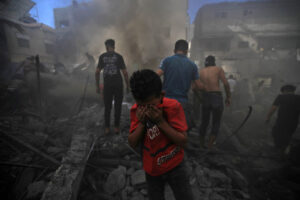Bomb the area, gas the tunnels: Israel’s unbridled war on Gaza’s underground

Palestinians recover the dead and rescue the wounded members of the Shaqura family, buried under the rubble of their home in the centre of Khan Younis, southern Gaza, 6 November 2023
Yuval Abraham reports in +972 on 6 February 2025:
The Israeli army intensively bombarded residential areas in Gaza when it lacked intelligence on the exact location of Hamas commanders hiding underground, and intentionally weaponized toxic byproducts of bombs to suffocate militants in their tunnels, an investigation by +972 Magazine and Local Call can reveal.
The investigation, based on conversations with 15 Israeli Military Intelligence and Shin Bet officers who have been involved in tunnel-targeting operations since October 7, exposes how this strategy aimed to compensate for the army’s inability to pinpoint targets in Hamas’ subterranean tunnel network. When targeting senior commanders in the group, the Israeli military authorized the killing of “triple-digit numbers” of Palestinian civilians as “collateral damage,” and maintained close real-time coordination with U.S. officials regarding the expected casualty figures.
Some of these strikes, which were the deadliest in the war and often used American bombs, are known to have killed Israeli hostages despite concerns raised ahead of time by military officers. Moreover, the lack of precise intelligence meant that in at least three major strikes, the army dropped several 2,000-pound bunker-buster bombs that killed scores of civilians — part of a strategy known as “tiling” — without succeeding in killing the intended target.
“Pinpointing a target inside a tunnel is hard, so you attack a [wide] radius,” a Military Intelligence source told +972 and Local Call. Given that the army would have only a vague approximation of the target’s location, the source explained, this radius would be as large as “tens and sometimes hundreds of meters,” meaning these bombing operations collapsed multiple apartment buildings on their occupants without warning. “Suddenly you see how someone in the IDF really behaves when given the opportunity to wipe out an entire residential block — and they do it,” the source added.
The investigation also reveals how Israel has known for years that the use of bunker-buster bombs releases the lethal gas carbon monoxide as a byproduct, which can kill people inside a tunnel through asphyxiation even at a distance of hundreds of meters from the strike location. After discovering this by chance in 2017, the army first tested it as a strategy in Gaza in 2021, and employed it in its efforts to kill Hamas commanders after October 7. This way, the army could attack targets without knowing their precise location, and without having to rely on direct hits.
“The gas stays underground, and people suffocate,” Brig. Gen. (res.) Guy Hazoot, the only source willing to be named, told +972 and Local Call. “[We realized] we could effectively target anyone underground using the Air Force’s bunker-buster bombs, which, even if they don’t destroy the tunnel, release gases that kill anyone inside. The tunnel then becomes a death trap.”
In January 2024, a spokesperson for the Israeli army told +972 and Local Call in response to a previous investigation that it “has never used and does not currently use byproducts of bomb deployment to harm its targets, and there is no such ‘technique’ in the IDF.” Yet our new investigation reveals that the Air Force conducted physio-chemical research on the effect of the gas in enclosed spaces, and the military has deliberated over the method’s ethical implications.
Three Israeli hostages — Nik Beizer, Ron Sherman, and Elia Toledano — were definitively killed by asphyxiation as a result of a November 10, 2023, bombing that targeted Ahmed Ghandour, a Hamas brigade commander in northern Gaza. The army told their families that, at the time of the bombing, it was unaware that hostages were being held near Ghandour. However, three sources with knowledge of the strike, which was led by the Shin Bet, told +972 and Local Call there was “ambiguous” intelligence indicating that hostages might be in the vicinity, yet the attack was still authorized.
According to six sources, this was not an isolated case but one of “dozens” of Israeli airstrikes that likely endangered or killed hostages. They described how the military command greenlighted attacks on the homes of suspected kidnappers and the tunnels from which senior Hamas figures were directing the fighting.
While attacks were aborted when there was specific, definitive intelligence indicating the presence of a hostage, the army routinely authorized strikes when the intelligence picture was murky and there was a “general” likelihood that hostages were present in the vicinity of a target. “Mistakes definitely happened, and we bombed hostages,” one intelligence source said.
